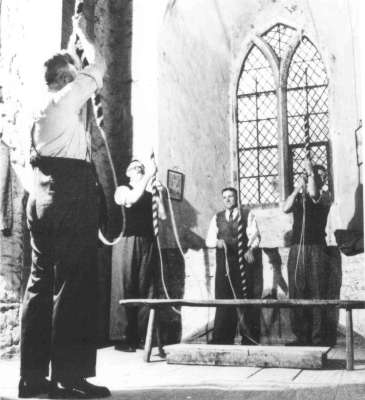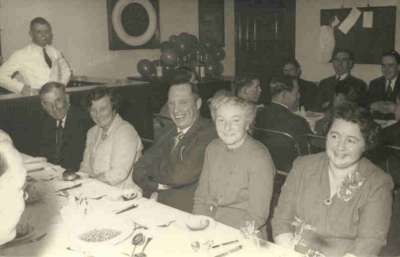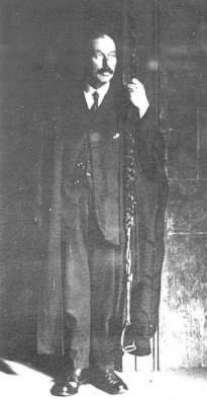
The Banbury Branch and its development
The Banbury Branch of the Oxford Diocesan Guild of Church Bellringers lies in the rolling hills of North Oxfordshire extending from the Warwickshire border in the north to a point about 10miles south of Banbury. It is bordered to the east by Northamptonshire and the River Cherwell except for the towers of Rousham and Lower Heyford which are just to the east of the Cherwell. To the west the branch runs to the edge of the Cotswolds along the Warwickshire border.
The first Branch in the area was inaugurated on June 20th 1896 at Bloxham. Before the meeting some unsuccessful change ringing was attempted and after the service and tea the Rev. F. E Robinson, Guild Master, explained the workings of the Guild. It was agreed to set up the Deddington Deanery Branch. The Rural Dean was elected President and Mr. W Bradford of Bloxham Secretary. It was decided to hold two meetings a year and to offer help to towers through Guild Instructors of which Mr. Bradford was one. Nine towers joined the Branch with a total membership of seventy two ringers. These included Adderbury, Banbury, Bloxham, Deddington, South Newington and Great Tew.
The first meeting was held at Adderbury in October 1896 with eight towers represented by forty plus ringers. However the ringers were unable to ring changes. Over the next few years the Branch ringers resisted all attempts to develop change ringing and in 1903 with eighteen members from only five towers the Branch stopped functioning.
In 1925 Maurice Smith of Banbury persuaded local ringers that a Branch was needed in North Oxfordshire and a meeting was held at Banbury on June 20th where it was decided to form the Banbury and District Branch. R. Lewis was elected secretary and the affiliated towers were Adderbury, Banbury, Cropredy, Deddington, Great Tew, Warmington and Wardington. There were eleven honorary members and forty three ringers. The first quarterly meeting was held at Deddington.
By 1932 Edward Pearson had taken over as secretary and nine more towers had joined the Branch. By 1934 there were one hundred and forty three ringers and twenty six honorary members. Since then Warmington has passed to the Coventry Guild and ten more towers have joined. Swerford has transferred to the Chipping Norton Branch.

Edward Pearson served as Secretary for 25 years; since 1956 a succession of Officers has maintained the running of the Branch. These include: H L Roper, Charlie Herbert, Barry Davis, Ron Thorne, Graham Clifton, Sue Burchell, Ian Rodrick and Joan Warren. In spite of some lean years a good number of both older and established ringers and younger inexperienced members is usually represented at meetings.
However, the minute books, which make fascinating reading, show that this has not always been the case. Those of 1928 record that the feasibility of holding monthly practices was discussed but there was a problem of too many towers needing repairs and too few method ringers to support them. In 1948 only fourteen members attended a quarterly meeting at Steeple Aston. 1950 evoked a Guild comment on the scarcity of young ringers in the area. This was evidently taken seriously as the secretary reported in 1956 that ‘towers have done a great deal in recruiting and training young ringers’.
Attempts to resolve the problem of towers needing repairs were put in hand from the early days and considerable work has been undertaken throughout the Branch’s 80 years. Adderbury were rehung in 1927 and Banbury rehung and augmented in 1929. Somerton received attention in 1929, Cropredy tenor was rehung in 1932 at a cost of £23!! and by 1938 Swalcliffe , Rousham, Hanwell and Wroxton had been restored to a ringable condition. Two trebles were added to Deddington in 1946, Duns Tew was restored in 1953. Due to movement and cracks in the steeple, ringing at Bloxham had been very limited prior to 1956 when the situation was remedied. A new wooden frame and gallery were installed at South Newington in 1959. In 1974 Bodicote were rehung and augmented to a light eight. Since then Cropredy, Deddington, Hanwell, Mollington, North Aston, Steeple Aston, Somerton, Steeple Barton and Wiggington have all been rehung and augmented and Wroxton, Wardington, Tadmarton and Rousham have been rehung.

In 1958 the first Dinner and social took place with ‘dancing, Christmas games and handbell ringing and so on’ and dinners although more formal of late have continued ever since. Boxing Day ringing at Deddington since the late 1930s has become a Branch tradition joined more recently by New Year’s day ringing at Banbury. In 1971 a Newsletter was started to keep members informed and continues today alongside the website. There have also been close links with other Branches with activities ranging from joint practices to cricket matches. The Branch has remained socially active with a committee whose task is to organise various social events.
Like most organisations the Banbury Branch has produced its personalities. Several past members have been awarded life membership for over forty years unbroken service. Recently Bob Reeves was awarded life membership for 50 years service. Looking back Frederick Selwyn who died in 1967 aged 96 was still actively ringing at the age of 90.

H L Roper secretary 1956-1963 was the first to aspire to Guild Office – that of Librarian. Since then Ron Thorne and Graham Clifton have been Guild Masters and Barry Davis a Guild Steward. Frederick Churn rang his first peal in 1977 aged 64 straight after which, he dug a grave! Lady members were first elected in 1928 and are very much in evidence now.
In 1964 the first Striking Competiton was held and has remained part of the social and ringing calendar. A ‘Firsts Day’ is now held in February so that anyone can have their first go at ringing a quarter, a method, a heavy tenor etc. and this has proved very successful. Over the years many peals have been rung by Branch bands and these range from Doubles to Surprise Royal.
As the Branch comes up to its 80th Anniversary it is very much alive and well and it is hoped it will continue for another 80 years.
